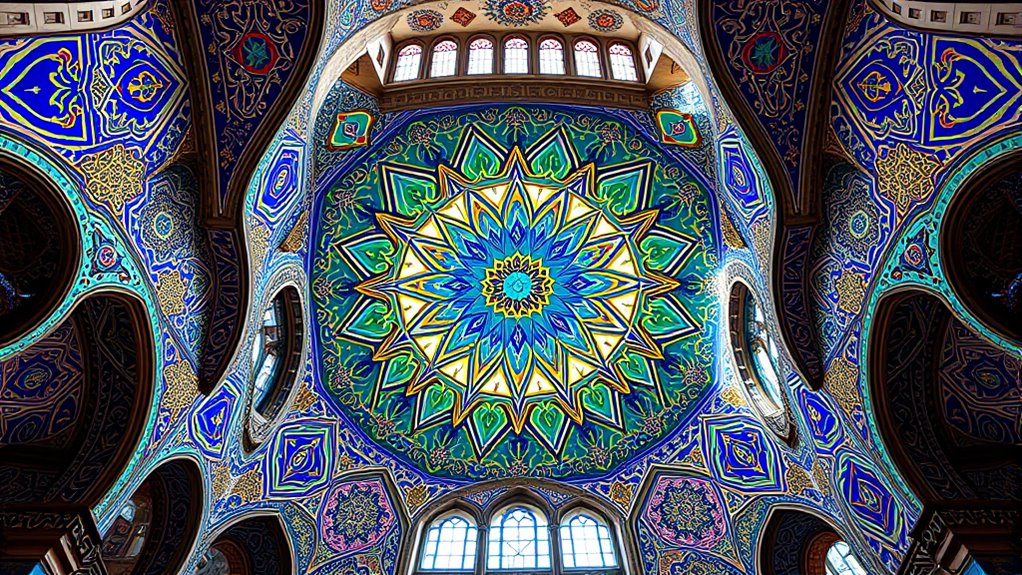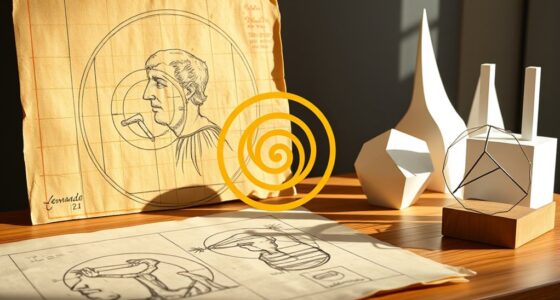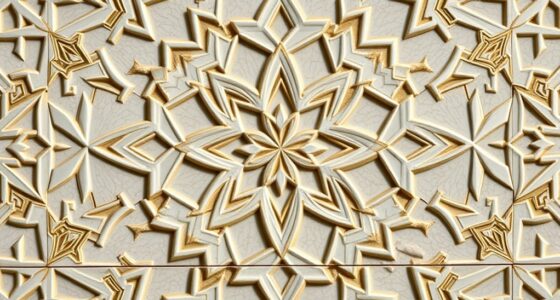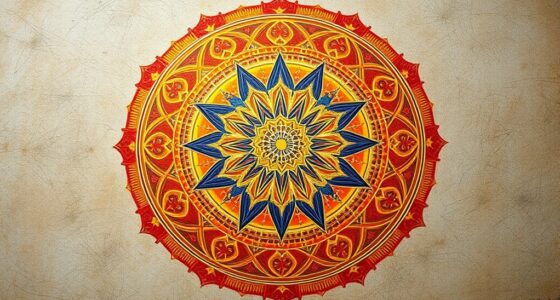Geometric patterns in architecture, from mosques to cathedrals, serve as visual expressions of divine order and spiritual harmony. You’ll notice how intricate designs embody sacred geometry, creating rhythm, balance, and symbolism that elevate the sacred space. Repetition and symmetry evoke eternity and divine presence, inspiring awe in visitors. Modern techniques enhance traditional motifs, blending tradition with innovation. Keep exploring to discover how these patterns transform ordinary structures into symbols of spiritual connection.
Key Takeaways
- Geometric patterns symbolize divine infinity and spiritual harmony, prominently used in mosques and cathedrals to elevate sacred spaces.
- Repetitive motifs create visual rhythm, guiding contemplation and emphasizing divine order across religious architecture.
- Sacred geometry’s precise proportions foster awe and reinforce spiritual concepts like omnipresence and unity.
- Modern technology enhances traditional patterns, allowing intricate designs that deepen the spiritual and aesthetic impact.
- Incorporating geometric motifs transforms ordinary structures into sacred landmarks, inspiring reverence across diverse religious architectures.

Geometric patterns have long played a crucial role in architectural design, transforming ordinary structures into visually striking works of art. When you observe sacred geometry, you’re witnessing a universal language that connects mathematics, spirituality, and aesthetics. These patterns aren’t just decorative; they embody principles believed to reflect the fundamental order of the universe. In architecture, sacred geometry often manifests through precise proportions and shapes like circles, squares, and triangles that evoke harmony and balance. You’ll see this in the intricate tile work of mosques, where complex geometric motifs symbolize the infinite nature of divine creation. These designs use pattern repetition to create a sense of rhythm and continuity, guiding your eye across vast surfaces and inviting contemplation. The repetition of patterns isn’t random; it’s carefully planned to evoke a feeling of unity and eternity, reinforcing the spiritual significance of the space.
As you move through historic mosques or cathedrals, you’ll notice how these repeating patterns serve more than aesthetic purposes—they embody spiritual concepts. In Islamic architecture, pattern repetition is fundamental. It transforms plain surfaces into mesmerizing tapestries that encourage reflection and meditation. The repetition of geometric motifs also signifies the infinite nature of God, with no beginning or end, giving worshippers a visual reminder of divine omnipresence. Similarly, in Gothic cathedrals, you see elaborate stained glass windows and vaulted ceilings filled with geometric patterns. These serve to elevate the spiritual experience, emphasizing divine order through symmetry and repetition. The pattern repetition in these structures isn’t merely decorative; it’s a deliberate tool to create an environment that inspires awe and reverence.
Additionally, the use of advanced technology in modern architectural design has allowed for even more intricate and precise geometric patterns, blending tradition with innovation. In both Islamic and Christian architecture, geometric patterns reveal a shared desire to express spirituality through mathematical precision. Pattern repetition helps architects achieve a sense of harmony that resonates with viewers on a subconscious level. It’s like a visual mantra, reinforcing the sacred nature of the space. You might notice how these patterns often flow seamlessly from one element to another, creating a cohesive visual story. This interconnectedness enhances the spiritual ambiance, making the structure more than just a physical space—it becomes a conduit for divine connection. Ultimately, the use of sacred geometry and pattern repetition in architecture isn’t accidental; it’s a deliberate effort to mirror the universe’s divine order, transforming ordinary buildings into sacred landmarks that continue to inspire awe across centuries.
Frequently Asked Questions
How Do Geometric Patterns Influence Modern Architectural Design?
Geometric patterns influence modern architectural design by emphasizing mathematical precision and creating visual harmony. You notice how these patterns guide your perception, making spaces feel balanced and cohesive. Architects incorporate them to achieve aesthetic appeal and structural stability. By using symmetry, repetition, and intricate shapes, they evoke a sense of order and sophistication, enriching your experience of the building while showcasing the timeless beauty of geometric principles.
What Tools Do Architects Use to Create Complex Geometric Patterns?
You use digital drafting tools like AutoCAD and Rhino to create complex geometric patterns efficiently. Parametric modeling software such as Grasshopper or Revit helps you design intricate, adaptable patterns by manipulating parameters easily. These tools allow you to experiment with shapes, angles, and symmetries quickly, ensuring precision and creativity in your architectural designs, especially when working with complex geometric motifs inspired by historical patterns.
Are There Cultural Significances Attached to Specific Geometric Motifs?
You’ll find that specific geometric motifs often carry deep cultural symbolism and spiritual meanings. For example, the star pattern can symbolize harmony or divine connection, while intricate tessellations may represent infinity or unity. These motifs reflect the beliefs and values of the culture that created them, serving as visual expressions of spiritual concepts. By understanding these symbols, you gain insight into the cultural and spiritual significance embedded in architectural design.
How Do Geometric Patterns Impact the Structural Integrity of Buildings?
Think of geometric patterns as the backbone of your building’s strength. They guide structural reinforcement, distributing loads evenly and resisting stresses. By cleverly using patterns, you achieve material efficiency, ensuring every element supports the whole. These designs aren’t just aesthetic—they enhance stability, making your structure more durable. When you incorporate such patterns, you optimize both beauty and function, turning intricate visuals into practical safeguards for your architecture.
Can Geometric Patterns Be Sustainably Incorporated Into Contemporary Architecture?
You can sustainably incorporate geometric patterns into contemporary architecture by using eco-friendly materials like recycled metals and sustainable concrete, which reduce environmental impact. Additionally, embracing adaptive reuse allows you to repurpose existing structures with intricate geometric designs, minimizing waste. These approaches blend aesthetic appeal with sustainability, helping you create innovative buildings that are both beautiful and environmentally responsible.
Conclusion
As you explore these intricate geometric patterns, imagine stepping into a vast, woven tapestry where every line and shape interlocks perfectly, guiding your eye and spirit. These designs aren’t just decorations; they’re the heartbeat of architecture, connecting cultures and eras like a shared language of symmetry and harmony. By appreciating their beauty, you unveil a window into humanity’s timeless quest for order amid chaos, revealing that in every pattern, there’s a story waiting to be discovered.









